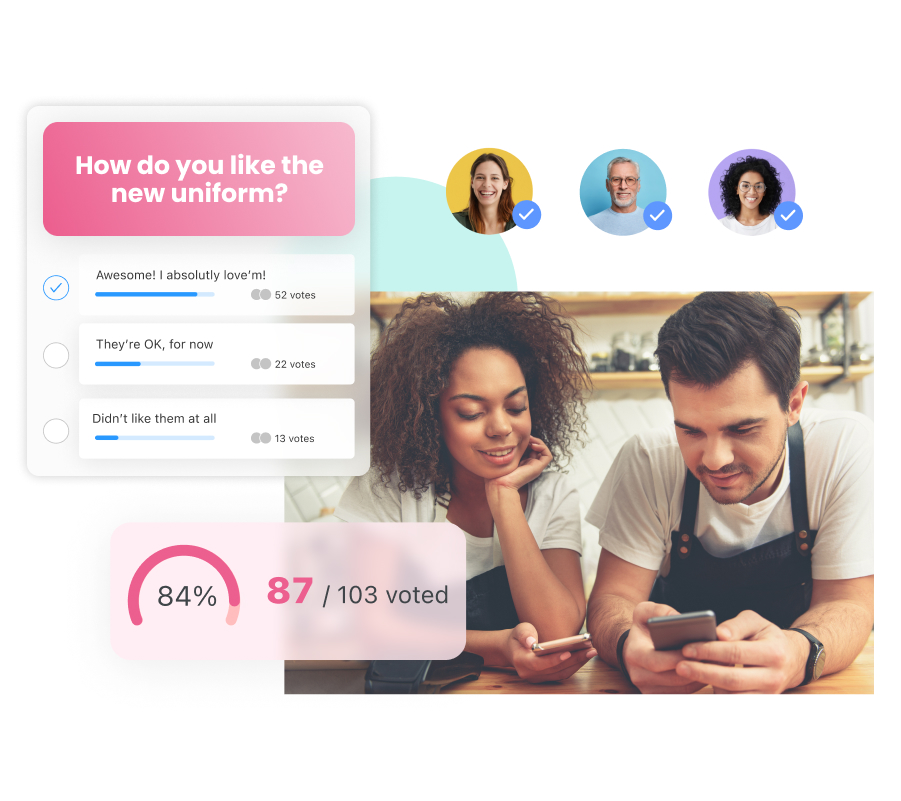In this article, we explore the 11 best employee training methods, take a look at employee learning styles, and share top tips on how you can get the most out of employee training.
Investing in employee training and development increases employee productivity, enhances company culture, and keeps your business ahead of the curve.
However, choosing the right employee training method for your team can be tricky—especially when your team members work in different locations and at different times. This can make it difficult for your team to engage in training and may make it hard for them to retain knowledge.
We’re here to lend a helping hand. In this article, we cover the 11 best training methods for employees, explore different worker learning styles, and share top tips to get the most out of your training.
Key Takeaways
- Picking the right employee training method increases training effectiveness, enhances the employee experience, and boosts employee development.
- Training your employees is also great for your business, as it can help reduce turnover and reduce the need for you to hire externally.
- You must consider your employees’ learning styles when picking an employee training method. Not all training methods will appeal to all people.
The Importance of Choosing the Right Training Method
Whether you’re creating a training program for a franchise or an independent business, planning and presenting training sessions takes time and effort. Therefore, it’s essential that you get the most out of each training session. Choosing the right training method is the first step in this process.
Picking a suitable training method is important because it:
- Increases training effectiveness. Picking the right training method and embracing employees’ learning styles will maximize their retention of the training content.
- Is cost-effective. When employees understand the material the first time, you won’t need to hold multiple, costly training sessions.
- Enhances the employee experience. Tailored training enhances the employee experience by showing them that you value their ambitions and development. A good training experience can increase employee motivation, too. It can also help empower your workers and create a culture of continuous learning.
- Helps properly develop employees. Well-executed training will increase an employee’s skills and capabilities. This will help your employees develop in their roles and get them ready for workplace promotions and additional responsibilities. In turn, you create a highly skilled workforce using your existing team.
- Helps with internal recruitment. Training employees to develop their existing skills and learn new ones can mean you won’t need to recruit externally to fill new roles, which is often expensive and time-consuming. Instead, you can recruit from within your organization.
- Can reduce employee turnover. Proper, well-executed training sets workers up for success. Employees who feel like they have the skills and knowledge to do their work well are less likely to quit.
Employee Learning Styles
Just as your team members each have a different personality type, they’ll likely have unique learning styles. To get the most out of your training sessions, it’s important to understand your employees’ different learning styles and try to plan your training around how they learn best.
VARK, Honey and Mumford, and Kolb’s learning cycle are generally considered the most useful learning models. Let’s explore them a little further.
VARK
Developed by Neil Fleming in 1987, VARK is a learning model that identifies employees’ learning preferences and how they best take in information. It stands for:
- Visual. These individuals learn best with visual aids—for example, graphs, images, and diagrams. They may doodle a lot during training and prefer symbols to words.
- Aural. These people learn best by actively hearing information. They’ll likely prefer video, in-person, or instructor-led training over other methods.
- Read/write. These individuals learn best by being given written information to read and digest in their own time. They may prefer e-learning methods or traditional reading material to help them learn.
- Kinesthetic. These people are known as the “do-ers.” They learn best through play and tactile learning—being able to physically touch things. They tend to prefer job shadowing and on-the-job learning.
Most people will have a pretty good idea about how they learn best simply by reading the different learning styles and considering how they look up new information in their day-to-day lives.
For example, if they’re trying to hang shelves up in their house, do they look up a video to watch, call a friend and ask them to explain the proper steps, read the instruction manual, or dive in and learn from their mistakes as they go? These denote visual, read/write, aural, and kinesthetic learners, respectively.
You may have an inkling about your employees’ learning styles, but to ensure accuracy, it’s best to send out a survey asking your team members to share their learning styles. We recommend using a digital survey tool, such as Connecteam, to create and share fully customized surveys in minutes.

Then, you can tailor your training sessions to your employees’ learning styles. For example, if you find that your team is mostly aural learners, having them participate in a training session that requires a lot of reading will be ineffective. Instead, opt for peer-to-peer learning or job shadowing.
That said, try to take all 4 learning styles into account for maximum impact. Not all employees will have the same learning style, so include a mix of delivery methods that appeal to visual, reading, aural, and kinesthetic learners.
🧠 Did You Know?
Employees can update their personal page in Connecteam’s employee directory to include useful information like their learning styles. This makes it easier for you to personalize training sessions for our team.
Honey and Mumford
Like VARK, Honey and Mumford is a learning model that identifies how a person learns best. It was developed by Peter Honey and Alan Mumford in 1986 when they identified 4 unique learning preferences.
As above, most people have a good idea of what their Honey and Mumford style might be just by reading the different learning types. However, to formally establish a Honey and Mumford learning style, you’ll need your employees to fill out a learning styles questionnaire.
The Honey and Mumford theory states that you can fall into 1 or 2 categories of learners. These are:
- Activists, who learn best by doing. They’re similar to the VARK model’s kinesthetic learners. They learn best in groups and through new experiences. Role-playing, gamification, and peer learning will be best for the Activists in your team.
- Theorists, who like to understand the “how” and “why” of what they’re being taught. “Just because” won’t be good enough for Theorists. They’re often scientifically minded and need to understand the theory behind the method. These learners will appreciate instructor-led training where they can ask lots of questions and take notes.
- Pragmatists, who learn best when they can see how what they’re learning applies to the real world. They like practical examples of how what they’re learning will be useful. Try using case studies with the Pragmatists in your team to help them understand the practicalities of what they’re learning.
- Reflectors, who like to observe others and then reflect on what they’ve learned. They don’t like to jump in like an Activist or Pragmatist would. Instead, they prefer to take their time before making a decision. One-on-one coaching, mentoring, and small coaching will be most beneficial for this group.
Try incorporating different activities into your group training sessions to ensure all learning styles are catered to.
For example, this could look like including a role-play activity, instructor-led training, a pop quiz, and a reflective group discussion in the session.
Kolb’s learning cycle
Kolb’s learning cycle is a learning model that explains that a person must go through 4 stages of learning before an idea or skill is fully embedded in their mind—regardless of their learning preference.
The 4 stages are:
- Concrete experience. This stage is the learner’s first exposure to the concept being taught. Concrete experience can come from in-person learning, an educational video, peer learning, or any other coaching style.
- Reflective observation. At this stage, individuals need to observe someone else taking the action or behavior they’re learning about. For example, a retail worker may watch their manager process a return on the cash register and be verbally coached through the process.
- Abstract conceptualization. Sounds complicated, but it isn’t! This means that learners need to approach what they’re learning from a logical perspective. It involves understanding the reasons why a task is completed the way it is. An example of this is a nurse learning about administering medicine through an IV infusion. They learn how medicine is delivered via IV infusion, and thus why it’s vital to consider proper timing and dosage before administering medicine.
- Active experimentation. This is where employees find “their way” of doing things. In an ideal world, everyone would perform tasks exactly how they were taught to do them. But, in reality, everyone has their own way of doing things. For example, some baristas might prefer to froth the milk for a cappuccino before they make the espresso. Some might make the espresso before they steam the milk. Both are valid ways of making a cappuccino—it’s just personal preference which process the barista follows.
To use Kolb’s learning cycle in your employee training, ensure you design sessions that encompass all 4 stages.
Offer hands-on activities for concrete experience and peer-to-peer learning opportunities for reflective observation. Be sure your training materials clearly explain the reasons behind certain tasks (to hit the abstract conceptualization stage) and set up role-playing exercises and on-the-job activities (to encourage active experimentation).
Finally, give employees plenty of time to digest the training content. This will help them embed the new information in their long-term memory.
11 Employee Training Methods & Techniques
Now that you’re in the loop about different learning styles, let’s discuss employee training methods and techniques. Here’s our list of the top 11 employee training methods you can use at your organization.
Instructor-led training
People usually think of instructor-led training (ILT) when they picture workplace training. It’s a very traditional method of training where a professional instructor trains an in-person group on a specific topic.
Typically, the instructor is responsible for creating the training, presenting it, guiding learners through the material, and taking any follow-up questions. They’re usually experts in their field and can give employees real-world examples of what they are teaching.
ILT is a great employee training method for audio or visual learners, as well as Theorists and Reflectors. This is because of the slow-paced nature of ILT. These more considered learners will have more time to process the information presented to them, contemplate different angles, and ask questions.
Pro tips for instructor-led training
- Set measurable learning goals prior to instructor-led training. This will help your employees understand their learning objectives and make it easy for you to gauge the effectiveness of training.
- Ensure your employees are prepared. It’s a nice idea to set out notepads, pens, and bottles of water for your employees before an ILT session. This adds a sense of importance to the occasion and will encourage them to take the training seriously.
E-learning and technology-led learning
E-learning and technology-led learning can involve digital learning management systems (LMS), dedicated training software platforms, mobile learning apps, interactive simulations, virtual reality (VR) training sessions, and more.
These types of learning have grown in popularity in recent years. This is due to the flexibility, accessibility, and cost-saving abilities of these approaches.
For example, you can create a completely digital training course and send it to employees via a mobile app. They can then complete it at a time and place that’s convenient to them. This is a much more cost-effective process than scheduling and organizing an in-person training session.
What’s more, e-learning is highly customizable. It’s easy to change the title of a course, update questions on a training quiz, revise notes in an e-learning video, and change the pictures in a digital training presentation.
You can also easily customize your training materials to suit your employees’ learning needs.
For example, if you have a team full of visual learners, it’s easy to change your training material to include lots of graphs and pictures. For aural learners, you can include training videos or audio recordings that read material to them. For kinesthetic learners, you can add quizzes or learning games to training sessions.
Pro tips for e-learning
- Keep it short and engaging. Online training fatigue is real, and up to 69% of employees who work and train from home experience burnout. You can prevent this by keeping online training to bite-sized modules (about 10-15 minutes long) and encouraging regular breaks.
- Encourage employees to use e-learning regularly. When employees brush up on their skills and knowledge during downtime, it’s known as “micro-learning.” This contributes to a culture of continuous personal development.
🧠 Did You Know
Connecteam’s all-in-one work management platform enables you to create your own custom training courses, upload training videos, add quizzes to modules to test employees’ knowledge, store training documents in the knowledge base, ask questions through the in-app chat feature, and so much more.
On-the-job learning
On-the-job learning is a critical element of employee training. In fact, the “70:20:10” model states that 70% of workplace training comes from on-the-job learning. The other 20% comes from peer-to-peer learning, and the final 10% from leader or course-based learning.
On-the-job learning involves learning through participation. It’s a time-honored and cost-effective way of learning, as employees are completing the work they’re paid to do and learning at the same time.
On-the-job learning is great for VARK kinesthetic learners, as well as Pragmatists and Reflectors under the Honey and Mumford learning model.
Pro tips for on-the-job learning
- Ask employees to help with tasks that are outside of their job scope. This is called a “stretch task” or “stretch assignment” and is a great way to upskill employees. Ask your worker to apply all the knowledge they already have about their role to this newly assigned task.
- Resist the urge to give employees all the answers. This ties into the previous tip. When an employee asks you a question about a task, ask them what they think they should do instead of just giving them the answer. Develop this into a conversation about the possible outcome of their actions. This will make them think about what would be best to do and may help them see tasks from a different perspective.
Job shadowing
Job shadowing is an element of on-the-job learning. It involves an employee following a more experienced colleague throughout their workday to observe how they complete tasks. It’s a great way for junior colleagues to learn the tricks of the trade and ask questions in real time.
Job shadowing works best for visual or kinesthetic learners, as well as Activists or Pragmatists. It’s also a great way to streamline Kolb’s learning cycle’s abstract conceptualization and active experimentation stages.
What’s more, employees can shadow anyone in the business. This means junior employees can shadow managers to see if they have the necessary skills to lead a team. Or, they can shadow a colleague from another department or location to see their working methods. It’s a great way to upskill or cross-skill your employees.
Pro tips for job shadowing
- Encourage your employees to take physical notes to ensure they don’t miss anything. It will also help them retain information. Encourage visual learners to use symbols or images in their written notes, or even take pictures or record videos if the training environment allows for it.
- Foster connections between your employee and workers in other teams or departments. While you’re providing job shadowing, introduce your worker to the people you interact with on a regular basis and strike up a friendly conversation.
Job rotation
Job rotation is a training method that involves swapping or rotating employees between a few different job roles at regular intervals.
An example of this would be rotating a hospitality employee between bar, management, and housekeeping roles on a weekly basis. This can help them better understand all aspects of the business.
Job rotation can help break up the repetition of doing the same job every day and can introduce employees to new skills or talents they may not have been aware of. It can also accelerate professional development, develop employees’ leadership skills, and increase retention.
Job rotation is perfect for aural or kinesthetic learners, Pragmatists, and the active experimentation aspect of Kolb’s learning cycle.
Pro tips for job rotation training
- Set SMART goals at the beginning of each job rotation and share them with your employees. Goals should be specific, measurable, achievable, relevant, and time-bound. For example, “You will work at the cash register for the next week. During that time, you’ll complete 2 customer service training quizzes, achieving at least a 90% score on each.” This will help you measure success in each job role and make the most of each rotation.
- Encourage employees to ask questions before, during, and after each rotation. It’s likely that each job rotation will bring different tasks, challenges, and learning opportunities—and it may be overwhelming for employees. Thus, it’s important to give them the space to ask questions as they come up.
Coaching
Coaching is a popular training method aimed at supporting employees’ long-term growth. It’s a great way to give pointers, can help employees correct behaviors and actions, and can mold employees’ skills over time.
When coaching employees, you should set clear and manageable goals and explain how they can achieve those goals.
You should also schedule regular meetings with employees to gather their feedback, see where they can improve and where they’re excelling, and offer advice and resources they may need.
In coaching, it’s important to frame your communications in as positive a light as possible. You can do this by opening the interaction with a compliment or praise where appropriate. For example:
I really appreciate the hard work you’re putting into learning how to close down the bar at night. But, in the future, it’s really important that you thoroughly brush and mop the floor under the sink. Otherwise, dirt can build up over time and might cause a safety issue.
Coaching can be helpful for on-the-spot learning, which is when you offer immediate training to address issues as they arise.
It’s a good idea to make a note of any coaching (including on-the-spot learning) that you give your employees. This way, you can build a log of all employee coaching records over time and check that employees are acting on your feedback. This is great for discussing during performance reviews.
Pro tips for employee coaching
- Give regular, consistent feedback. Offering regular feedback to employees will reinforce the skills, actions, and behaviors you’re hoping to teach them. It also makes employees more receptive to feedback since they’ll expect to receive it and it won’t come as a surprise.
- Encourage peer-to-peer coaching. Select one of your more senior employees to coach a more junior employee. You can use peer-to-peer coaching alongside standard coaching, too. This way, the employee has 2 mentors to learn from. This can help develop a feedback-rich culture within your business, foster great working relationships between your team members, and encourage continuous learning.
- Use the EEC method when giving feedback. This stands for example, explain, and change/congratulate. You’ll share an example of the employee’s action or behavior, explain the positive or negative effect it had, and then either discuss what they need to do to address it or congratulate them on a job well done.
Role-playing
Role-playing helps employees prepare for new or unusual situations in a controlled environment. It can build confidence, develop workers’ listening skills, and help employees understand customer or colleague behavior.
Role-playing can be especially useful for kinesthetic, aural, and Activist learning types.
However, role-playing can be anxiety-inducing for shy or introverted employees. Planning your role-playing sessions in advance and pre-warning your employees about what to expect will help them prepare for the training.
Pro tips for employee role-play training
- Have your employees role-play what they shouldn’t do during an interaction. Ask for “wrong” answers. For example, what should your employees not do when a customer is trying to return a product? Encourage them to be creative. This can also help break the ice if you’re training a new group.
- Swap roles frequently during the session. This can prevent employees from getting bored and ensures training stays fun and interesting.
Video training
Video training has grown in popularity over the last few years because it’s cost-saving, remote, and flexible. It allows employees to complete training at a time and place convenient to them.
Video training is a great tool for many different learning styles. For example, visual learners can benefit from the visual nature of videos, while aural learners can take in the words presented to them.
It may be less beneficial for kinesthetic learners. However, providing employees with hand-outs or worksheets to compete during video training is a good way to overcome this.
Moreover, video training is beneficial for employees who have specific learning difficulties, such as dyslexia or ADHD. Allowing employees to use video training means employees can rewind training if they miss something, pause to make notes, or watch at 1.5 times speed to enhance focus.
Pro tips for video training
- Focus each video on a single idea or concept. Trying to include too many points in one video will confuse and overwhelm employees. Each video can be part of a series of videos that cover a larger topic, such as workplace safety. In this example, a single video might be about the proper way to use a fire extinguisher on a job site.
- Keep videos as short as possible. About 2 to 5 minutes long is ideal. This way, employees can digest information quickly and won’t be faced with information overload. Plus, with multiple short videos instead of a single long one, you create a natural space for breaks during training.
- Prepare a script. Ensure it includes a friendly introduction that notes the concept or idea you’re covering, as well as detailed information about it.
Gamification
Gamification, or gamified training, involves bringing game-like elements into training sessions.
This could include using rewards, points, or badges to reward good behavior. You could also try leaderboards, collaborative tasks, or progress bars to measure training.
Gamification breaks down barriers to learning and helps employees loosen up a bit during training. This will allow employees to engage with your teaching and retain their knowledge. It’s also a great way to develop your company culture.
Pro tips for gamified training
- Model your training after a well-known game—for example, Monopoly. Create a game board and custom pieces to give to each employee taking part in the session. In the first half, hold training as you normally would—using videos, instructor-led sessions, job rotations, etc. Then, for the second part of the session, present the board and pieces. Tell your employees they can progress along the board by completing training tasks or answering questions.
- Offer prizes to winners. This lets employees know there’s a reward for engaging in training—making them more likely to give it their all. Prizes don’t need to be expensive. They could be a gift card, a voucher for a meditation class, or even a half-day off.
🧠 Did You Know?
With Connecteam, you can reward employees with digital tokens they can exchange for gift cards. For more ideas, check out our roundup of 28 proven ways to reward employees.
Case studies and reading
Reviewing case studies and reading training material is another traditional method of employee training. Case studies can be especially useful in the medical or social work industries, as exploring past interactions and policy can be a useful way for employees to learn.
However, asking employees to read training material in the workplace may not be cost-effective, as it will eat up their paid working hours. It may also not be effective point blank. Employees may feel pressured to finish reading the material during the workday. This could cause them to skim-read and not properly digest the information.
Instead, give your employees copies of any reading material to take home. This way, they can read the material in their own time, make notes, and look up any topics they may need clarification on. This is especially important if your employees have learning difficulties such as dyslexia or dyscalculia.
Remember, case studies and examples in reading materials should either be fictitious or have names changed. This ensures confidentiality.
Pro tips for case studies and reading-based training
- Don’t forget: Readability is key. Ensure all reading material is printed in an easy-to-read font (a sans serif font in size 12 is generally good), is clearly structured, and uses formatting like bullet points and lists to break up information. Also, ensure there isn’t too much contrast between the background and the text. For instance, consider using black text on a cream-colored background. This can make the material easier to read.
- Track employees’ reading progress and completion. Using a platform like Connecteam makes this simple. You can use the document management tools to request e-signatures on any reading materials—such as training documents or new policies—once employees have worked their way through them. Also, you can track overall training progress through the central dashboard. This way, you can see how far along employees are in their reading.
Management-specific learning
This type of training is specifically for employees in managerial roles. They may be a long-standing manager receiving ongoing training or an employee who has been promoted to their first management position within your company.
In any case, management-specific training equips managers with the knowledge and skills necessary to lead teams and spearhead projects.
For instance, they can develop their skills in conflict resolution, strategic thinking, emotional intelligence, communication, problem-solving, performance management, and, of course, leadership.
Management-specific training is usually a bespoke plan tailored to the needs of the individual. For example, if an employee has great natural communication and conflict resolution skills, they won’t need training on this topic. However, they might need training in account management or strategic leadership.
Pro tips for management-specific learning
- Chat with your organization’s managers about what training they might need and what their learning style is. From this, you can create a bespoke management training plan that covers all the knowledge they’ll need to excel in their new role.
- Encourage managers to take ownership of their development and embrace out-of-work learning—for example, by reading management books, watching documentaries, or attending industry seminars.
Conclusion
Employee training is a key part of running a successful business, but it can be difficult to do well. You need to be able to align training across your whole team—or even multiple teams and departments—and ensure it’s easily accessible and tailored to your workforce’s needs and preferred learning styles.
After learning about the 11 best employee training methods we covered in this article, you can get started on creating training sessions and materials that are effective and impactful. We also recommend using a platform like Connecteam to streamline your training processes and support continuous learning at your workplace.
Get started with Connecteam today.
FAQs
What training methods are most effective?
It depends on the industry you work in, your job role, and your working environment. For instance, on-the-job, job-shadowing, and e-learning methods can be very effective for deskless workers, who don’t work in front of a computer and primarily use their mobile devices for communication. For office-based employees in executive roles, management-specific training might be best.
What are the 3 most common methods of training?
On-the-job learning, job shadowing, and using reading materials are the most common employee training methods.
What is the most widely used training method?
On-the-job learning is the most widely used employee training method.




